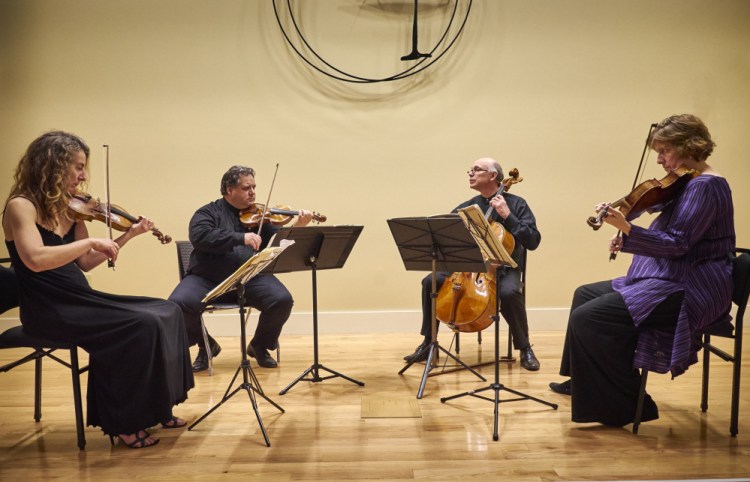As the DaPonte String Quartet explained it, the works on its “Memento Mori” program at the Maine Jewish Museum on Thursday evening had two things in common: They were written by young composers, and they are all about death. But that explanation needs parsing.
True, the composers were young when they wrote these works: Samuel Barber composed his String Quartet (Op. 11) in 1936, when he was 26; Thomas Adès was 23 when he wrote “Arcadiana” (1994), and Franz Schubert was 31 when he completed his magnificent “Two Cellos” Quintet in C (D. 956) in 1828.
But neither the Barber Quartet as a whole, nor its central Adagio – the only movement the DaPonte players performed – is about death. It was the work of a student eager for attention, and it brought Barber plenty, especially after Arturo Toscanini suggested recasting the Adagio as a work for string orchestra. The orchestral version had death thrust upon it: It has been used for presidential funerals and other somber occasions, and in films where mournful-sounding music is required, but that association came after the fact.
Schubert died shortly after he completed his quintet, his final chamber work. While he knew that his days were numbered, the work bears no trace of that; indeed, the rich melodies of its opening movement, its glowing Adagio theme, the folksy brusqueness of its Scherzo and the dance figures laced through its finale sound far more like a celebration of life than an anticipation of death.
That leaves the Adès. Here, the quartet has a point. A work flecked with musical quotations (bits of Debussy, Mozart, Schubert, Bernstein and Elgar flit through the score) and allusive movement titles, “Arcadiana” was composed at the peak of the AIDS epidemic and is meant as a memorial and a meditation on mortality, couched in visions of Arcadia, a mythical paradise from Greek mythology.
The quartet began with the Barber, a work that, in its quartet guise, has a sparseness and astringency that is lost in the orchestral edition. The quartet score also offers greater clarity: All four lines, and every shift in dynamics, coloration and balance are thoroughly exposed.
That can be a double-edged sword, since there are perilous bowing changes at climactic moments. The DaPonte players – violinists Lydia Forbes and Ferdinand Liva, violist Kirsten Monke and cellist Myles Jordan – gave a well-paced, rich-toned performance of the movement, though a couple of those tricky passages sounded awkward enough to break the performance’s spell, momentarily. But a bigger disappointment was that they did not play the full quartet, a wonderful piece that is too infrequently played, and which puts this meditative movement in the context Barber intended for it. I hope they add that to their to-do list for a future season.
The Adès is a challenging piece, partly because of the freedom with which its composer darts between consonance and dissonance, and partly because its shimmering, often pointillistic, constantly changing textures are meant to evoke visions of paradise that are otherworldly, yet also linked – by way of the quotations from Mozart’s “Magic Flute,” Schubert’s “Auf dem Wasser zu Singen,” and other works, as well as Adès’ colorful movement titles – to our reality.
The quartet gave the piece a wonderfully focused performance that brought its many contrasts and paradoxes to life, and most importantly, showed how Adès’ rich and often competing ideas – his paradise is alternately calming and terrifying – gelled into a cohesive, painterly whole.
For the Schubert, the DaPonte players were joined by cellist Scott Kluksdahl. This is one of the crowning works of the chamber repertory, as melodically opulent as anything Schubert composed, but earthy and spirited as well. There were odd moments in the opening movement, where the two cellists, playing the lush, tandem theme, appeared to have competing theories about where their notes were centered. But such issues were fleeting, and for the most part, the performance, which closed the group’s Portland season, was a joy.
Allan Kozinn is a former music critic and culture writer for The New York Times who lives in Portland. He can be contacted at:
allankozinn@gmail.com
Twitter: kozinn
Send questions/comments to the editors.



Comments are no longer available on this story